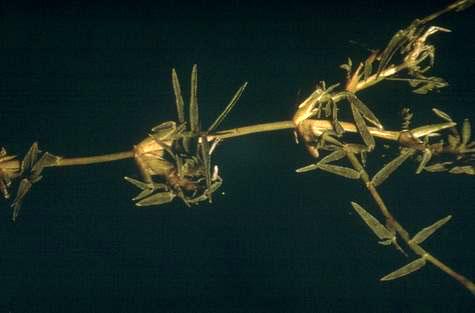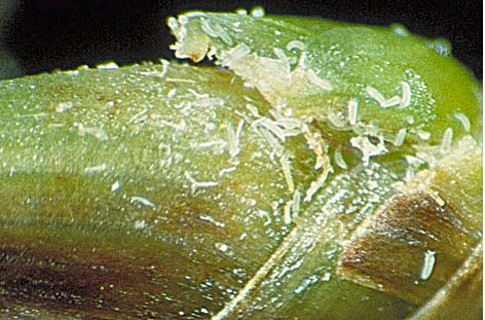Bermudagrass Mites and Zoysiagrass Mites: What’s Bugging Your Lawn?
- Seth Newell

- Jul 5, 2024
- 3 min read
Updated: Jul 4
Is your Bermudagrass or Zoysiagrass looking… off? Maybe it's thinning out, forming odd clumps, or just not bouncing back like it should despite solid fertilization and irrigation? If so, you're not alone—and you might be dealing with an invisible enemy. Enter the Bermudagrass mite (Aceria cynodoniensis) and the Zoysiagrass mite (Aceria zoysiae), two tiny culprits that can cause big trouble for Oklahoma lawns.
These microscopic pests are just 1/100th of an inch long—cream-colored and wormlike, with only four legs to their name. Despite their size, they can wreak havoc on your turf by stunting growth and causing deformations that make even healthy lawns look like something out of a horror movie.
Bermudagrass Mite and Zoysiagrass Mite Damage: What to Look For
Let’s get visual for a moment. Here’s how to spot the tell-tale signs:
Bermudagrass Mite
Rosette or “witch’s broom” appearance due to shortened internodes.
Clumping, tufted grass that may feel unusually tight or “knotted.”
Thin turf with poor regrowth and brown patches, especially during hot, dry spells.
A preference for lush, well-fertilized turf (yes, they’re attracted to healthy lawns—rude, we know).
Zoysiagrass Mite
Pale white or yellow streaks on leaves.
Upper blades curling into twisted, buggy-whip shapes.
Greater overall damage due to Zoysiagrass’s slower recovery rate.
Both mites take up residence under the leaf sheaths, where they lay eggs and complete a life cycle every 5–7 days. That’s multiple generations in a single season—yikes.
Which Grass Types Are Most Susceptible to Mite Damage?
Some cultivars take the hit harder than others.
Bermudagrass Varieties Most Susceptible: Most common types.
Resistant Bermudagrass Varieties: ‘Tifway’, ‘Tifgreen’, ‘Tifdwarf’, and especially ‘Midiron’, which is well-suited to Oklahoma conditions.
Zoysiagrass Varieties Most Susceptible: ‘Meyer’.
Resistant Zoysiagrass Varieties: ‘Emerald’ and ‘Royal’ are top choices, while ‘El Toro’ offers moderate resistance.
How to Identify Bermudagrass and Zoysiagrass Mites
You’ll need a 10x–20x hand lens or a dissecting microscope to confirm an infestation. Carefully peel back the leaf sheath near the base of suspicious-looking turf and inspect for:
Creamy, worm-like mites
Round, translucent eggs
How to Control Bermudagrass and Zoysiagrass Mites
When it comes to mites, there’s no silver bullet—but there is a two-pronged approach that works.
1. Mechanical Removal
Scalp the turf (cut it low) and remove the clippings from the property. This alone has been shown to reduce mite populations by 50% within a month, especially when done in late spring.
2. Chemical Treatment
Follow scalping with a targeted miticide application. Abamectin (e.g., Divanem) and combinations including imidacloprid, bifenthrin, and zeta-cypermethrin have shown efficacy when applied per label instructions. A licensed applicator (like, say, ahem, Newell Services) can help with this step.
3. Fertility Support
Apply nitrogen fertilizers during the early growing season to help turf recover and outgrow damage. A healthy, well-fed lawn can better resist and rebound from mite stress.
Best Timing for Mite Treatment
Spring: Be alert for stunted growth and rosettes as the lawn greens up.
Late Spring–Summer: Prime window for scalping and treatment.
Fall: Apply treatments to reduce mite populations for next spring.
Final Thoughts
Mites may be tiny, but their impact on Bermudagrass and Zoysiagrass is mighty. Stay vigilant, inspect regularly, and don’t hesitate to reach out for help when you see signs of infestation. An ounce of prevention—and maybe a sharp mower blade—is worth a pound of turf repair.
Let the neighbors worry about their weeds. You’ve got this. 🌱
— Newell Services, LLC | Make My Lawn Great! Licensed, Local, and Lawn-Obsessed in Northeast Oklahoma.👉 Submit a Work Request














